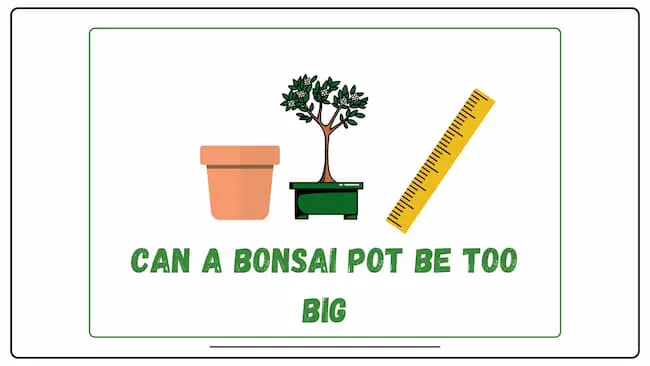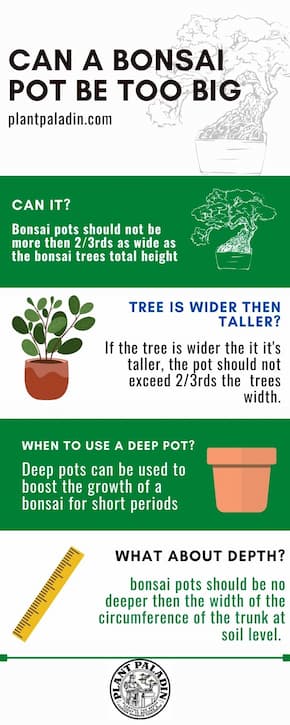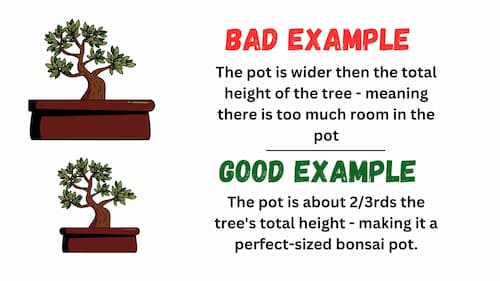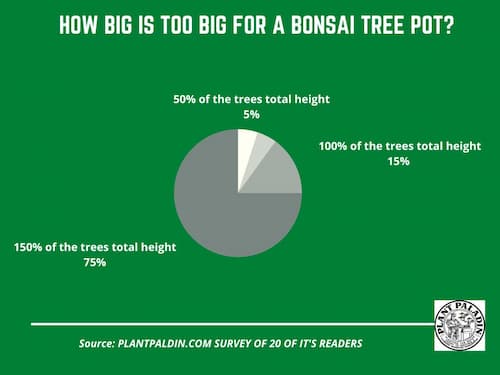This website is supported by its readers. If you click one of my links I may earn a commission. I am also a participant in the Amazon affiliates program and I will also earn a commission from qualified purchases.

So recently, I needed to repot my Chinese Elm bonsai tree as it had outgrown its pot. As we all know, leaving a bonsai tree in a small pot can crush its roots, absorbing less water and minerals. This got me thinking if the opposite was true with large pots, so can a bonsai pot be too big?
A bonsai tree pot can be too big if its length is more than 2/3rds the tree’s height. Having a bonsai tree pot that is too big can lead to waterlogged soil, which can lead to overwatering. If left unchecked, this can cause root rot or lead to an unhealthy tree.
So what is the best size pot for a bonsai tree? And when should you move to a larger pot for your bonsai tree? Keep reading to find out more.
Just a quick heads up, over the past three years of running Plantpaladin, hundreds of people have asked for product recommendations. As such, You can find my favorite indoor bonsai tree here (link takes you to Bonsaiboy), my favorite outdoor bonsai tree (link takes you to Bonsaiboy), or have a look at all the products I recommend here.
Can a bonsai pot be too big?
Easily one of the most complex parts to get to grips with when I first started getting involved with bonsai trees was bonsai pots.
While trimming and pruning my bonsai was simple enough, I was always nervous about using the right-sized pot for the tree.
As such, to ensure I cared for my trees in the best way possible, I contacted a few bonsai experts and visited my local botanical gardens to get to the bottom of this.
I also surveyed 20 plant paladin readers, asking them if there was such a thing as having a bonsai pot that was too big.
All to ensure that you have the most in-depth post on whether a bonsai tree pot is too big on the web.
To summarize:
Can a bonsai pot be too big – quick facts
- Bonsai tree pots can sometimes be too big for the bonsai trees they grow.
- As a general rule of thumb, your bonsai pot should be no more than two-thirds the height of a tree.
- For example, if your bonsai tree were 30cm, the ideal size of the pot would be 20cm wide.
- If your bonsai tree is wider than it is taller, then you would aim for the pot to be no more than 2/3rds the widest point of the tree.
- For example, if you have a bonsai tree that is only 15cm tall but 30cm wide, you would still aim for the pot to be 20cm.
- That said, should your bonsai tree pot be equal to the size of the widest point of your bonsai tree( for example, a 30 cm pot for a 30cm tall bonsai), then you can still successfully grow your bonsai tree without fear of any health issues.
- A general range then to stick to is to have a pot that is 75% to 100% the length or width (spending on what is wider) of your tree.
- Bonsai tree pots are traditionally shallow, with the depth of the tree usually being now more than the diameter of the tree’s trunk at the soil level.
- Bonsai trees, however, can be grown in deeper pots if you would like your tree to become taller or grow faster.
- However, the main problem with keeping bonsai in big pots will be the increased soil nutrients and water, which can cause overwatered roots and lead to root rot or other fungal diseases.
Now this is quite a lot of information, so let’s break this down in more detail.

How big is too big for a bonsai pot?
Now we know generally what a good bonsai pot looks like; how big is too big for a bonsai pot?
Having a bonsai pot that is more than 2/3rds the length of your bonsai tree at its tallest or widest point is too big. This will leave too much excess room in the pot, leading to root rot or fungal infections.
Bonsai tree pots that are deeper than the circumference of the trunk at soil level are also not recommended ( although I sometimes exceed this to boost growth and improve root strength)
If you have a bonsai tree pot that is 5 times the height of your bonsai tree, this will be way too big for your tree, especially if you are keeping it indoors.
Let’s give some good and bad examples below:
Bad example:
A bonsai pot that is 20cm long when the bonsai tree at its tallest point is only 10cm. In this example, the bonsai pot is almost double the length of the bonsai tree, meaning its roots will have way too much room.
Good example:
A bonsai pot that is 20cm long when the bonsai tree at its tallest point is 30cm. This example shows that the pot is precisely 2/3rds the size of the tallest point of the tree, making it the ideal ratio for a pot.

Bad example:
A bonsai pot is 40cm, when the bonsai tree at its widest point is only 20cm. As mentioned earlier, sometimes bonsai trees are more expansive than they are taller, especially in broom styles. In this scenario, instead of looking at the height, we have to consider the width of the tree. In this example, we can see that the tree is only 20cm at its widest point, meaning, once again, we have doubled the bonsai tree’s pot, making it too big for the tree.
Good example:
A bonsai pot is 15cm, when the bonsai tree at its widest point is only 20cm. Here the bonsai pot is around 75% the size of the width of the bonsai at its widest point, making it a great-sized pot for your tree.
Bonsai tree height or width (at the tallest or widest point)
Ideal pot size
Wrong pot size
10cm
7cm wide
15cm +
20cm
12cm wide
25cm +
30cm
20cm wide
35cm+
40cm
25 to 30cm
45cm +
50cm
33 to 38cm
50cm +
What about bonsai you plant in the ground outdoors?
So while the recommendations in this article are accurate, we have yet to speak about the giant earth-shaped hole in the room – planting bonsai in the ground.
You see, many of you will also be growing outdoor bonsai with species such as Juniper, Maple, and Pine.
So won’t you run into the same problems if you plant your bonsai in the ground instead of a pot?
After all, planting in the ground means an excess of soil and water, so won’t this impact your tree like growing in n oversized pot?
Not necessarily.
You see, most bonsai owners (myself included) only really plant bonsai trees in the ground for a short period, typically as a way of speeding up growth.
This is usually undertaken for about a year or two, during which bonsai are transferred to a regular shallow pot.
On top of this, most people who plant bonsai in the ground have the space in their yards to have a dedicated section for their bonsai trees, with specific soil, instead of just plopping their trees in the ground randomly one day.
What is the benefit of using deeper pots for bonsai?
So as mentioned earlier, typically, shallower pots that are around 2/3rds the size of your bonsai trees are the best option to grow your bonsai successfully.
That said, there is a discrepancy in the bonsai world on the depth of the pot.
Most bonsai pots are shallow and are about as deep as the circumference of the trunk of your bonsai tree is at the soil level.
That said, there are a few occasions when the option for a deep garden pot might prove more beneficial in growing your tree, mainly if your bonsai tree belongs to a relatively slow-growing species such as Ginseng Ficus, Jade, or Fukien Tea.
These trees only grow a few inches per year, so if you want to help speed up the process, consider planting these in a deeper pot which will allow the tree to grow much quicker.
Secondly, if your bonsai tree had become overwatered or some of the roots had become rotten, I would conder repotting your bonsai in a deeper pot.
This will allow the roots to dry out due to the excess soil and can be used to help save a dying bonsai.
Are shallow pots better than deeper pots for bonsai?
Shallow pots are typically better than deeper pots as they help control root growth and maintain the dwarf conditions of bonsai trees. Using shallow pots for bonsai is also much more traditional and far more commonplace.
Regular pots can be used occasionally for short periods if you want your tree to grow faster.
Do bonsai trees grow bigger in bigger pots?
Bonsai trees will grow larger and faster in deeper pots. This is because the roots will have more room to grow downwards, allowing them to absorb more nutrients and water. This, in turn, allows them to grow much larger than they would in shallow pots.
It is not recommended to grow bonsai trees in deep pots year around as this can interfere with the miniaturization process early on in a bonsai tree’s life, making it grow like a regular tree.
What do bonsai need shallow pots?
So we covered the benefits of having deeper bonsai pots; however, you should generally opt for shallow pots.
The biggest reason for doing so is because of the miniaturization process.
The shallow pots mean that bonsai trees only have a limited space to stretch and grow their roots.
This means that the tree must grow a certain way, which causes bonsai trees to become miniature trees if grown this way over a few years.
Instead, if you were to grow your bonsai tree from a seed in a regular deep pot, there would be nothing to stop your bonsai tree from just growing into a regular tree.
Problems with having a bonsai pot that is too big?
Having a bonsai pot that is too big for your bonsai tree can lead to several problems and challenges. Here are some potential issues:
Poor aesthetics
Bonsai trees are admired for their miniature size and the illusion of age and maturity they convey. The overall aesthetic appeal of the bonsai can be compromised. If the pot is too large, it can make the tree appear disproportionate and out of balance.
Root health
Bonsai trees require well-drained soil and appropriate moisture. If the pot is too big, the excess soil can retain too much water, leading to poor drainage and an increased risk of root rot.
The roots may not receive adequate oxygen, resulting in suffocation and potential root decay.
Nutrient distribution
Bonsai trees need a balanced nutrient supply to thrive. The tree may not receive adequate nutrition, leading to stunted growth and poor health. In a large pot, the soil volume is more significant, making it challenging to distribute nutrients throughout the soil properly.
Difficulty in watering
Watering a bonsai in an oversized pot can be challenging. Judging the amount of water, the tree requires becomes difficult, potentially causing root rot or other water-related issues.
The excess soil volume can retain water for extended periods, leading to overwatering.
Stability issues
A larger pot can make the bonsai top-heavy and unstable. The tree may be prone to tipping over or being affected by strong winds, potentially causing damage to branches, leaves, or the overall structure of the tree.
Pot-bound appearance
Bonsai trees are often pruned and trained to have a compact root system within a small pot. When the pot is too big, the root system may not fill the space adequately, resulting in a pot-bound appearance. This can detract from a well-developed bonsai’s natural and harmonious aesthetics.
When to put your bonsai in a bigger pot?
Transplanting a bonsai into a larger pot can be a tricky balance between feeling your tree needs to be repotted and needing to repot your tree. Here are some general guidelines for determining when to repot your bonsai into a bigger pot:
Root growth and development
Bonsai trees need sufficient space for their roots to grow and expand. If you notice that the roots have filled the current pot, circling the root ball or emerging from the drainage holes, it may indicate that the tree needs a larger pot to accommodate its root system.
Health issues
f your bonsai is exhibiting signs of poor health, such as stunted growth, yellowing leaves, or decreased vigor, it could indicate that the current pot is constraining the root development.
In such cases, repotting into a larger pot can provide the tree with the necessary space to rejuvenate and grow healthier.
Pot-bound appearance
Suppose the root system appears tightly packed within the pot, causing the soil to break down quickly after watering or inhibiting water absorption.
In that case, it may be time to consider repotting into a larger container. A pot-bound appearance indicates that the tree has outgrown its current pot.
Repotting cycle
Different species and individual bonsai trees have varying repotting cycles. Generally, deciduous trees are repotted every two to three years, while conifers are repotted less frequently, around every three to five years.
When the repotting time approaches, it’s an opportunity to assess whether the tree requires a larger pot due to root growth.
Season
Repotting is typically done during the tree’s dormant period in early spring or late winter, just before new growth emerges. This minimizes the stress on the tree and allows it to recover more quickly.
However, if the tree shows signs of severe root congestion or health issues, repotting into a larger pot may be necessary outside the regular repotting season.
When to avoid putting your bonsai tree in a bigger pot?
Recent repotting
Bonsai trees require a period of recovery after being repotted. Repotting too frequently can stress the tree and impede its ability to establish a healthy root system. Wait for a year or two before considering another repotting, even if the current pot seems too small.
Young or developing trees
Young bonsai trees, or those still in the early stages of development, should be placed in larger pots promptly. These trees often benefit from being kept in smaller pots to encourage the development of a compact and well-formed root system. It’s essential to allow the tree to establish a strong foundation before transitioning to a larger pot.
Unhealthy or weak trees
Suppose your bonsai tree is experiencing health issues like fungal infections, pests, or general weakness.
In that case, it’s best to focus on resolving those issues before considering repotting into a larger pot. Repotting can cause additional stress, and an unhealthy tree may not have the strength to recover successfully.
Trees in their dormant period
During the dormant season, typically in early spring or late winter, bonsai trees are in a state of rest.
Repotting a bonsai into a larger pot during this period is generally not recommended. The tree may need more energy reserves to recover quickly.
Wait until the tree begins to show signs of new growth and vigor.
Well-proportioned and balanced trees
If your bonsai tree is healthy and exhibits a balanced appearance in its current pot, repotting it into a larger container may be unnecessary.
Bonsai aesthetics emphasize the harmony between the tree and the pot size, so if the current pot complements its proportions, it’s best to leave it as is.
How to measure the perfect bonsai pot size for your tree?
The best way to measure and see if your bonsai pot is the perfect size for your bonsai tree is to ensure that it is 2/3rds to ¾ the size of your tree at its tallest or widest points.
I like to do this by simply getting a ruler and taking a rough length estimate.
If the pot is around 2/3rds the size of the tree, then the pot is a good size.
Now using a ruler can be challenging in bonsai, especially if your tree has a lot of ramifications and branches.
Another method is to use a piece of string or yarn and mark it along the length of the tree.
press it against the width or height of the tree ( whatever is longer). Then cut the yarn and measure it up against the pot.
Surprisingly, this method is more accurate than using a ruler.
When should you repot your bonsai tree?
Decdoiuse bonsai trees such as Chinese Elm or Ficus must be repotted once every 2 to 3 years. Conifers/evergreen bonsai trees, such as Juniper or pine varieties, can last much longer in a pot and must be repotted every 4 to 5 years.
Survey results
Finally, I didn’t just want to give my experience with having a bonsai pot that is too big.
I quickly surveyed plant paladin readers, asking them how big is too big for a bonsai pot.
Here are the results:

My top picks for the gear you will need!
So like I mentioned earlier, over the past three years of running PlantPaladin, hundreds of people have asked me for my recommendations on the best bonsai gear on the market.
Having spent thousands of dollars on bonsai items these past few years and tested at least 100 bonsai-specific products, I’ve listed my favorite products below – All of which I highly recommend and think you can get great value.
They can purchase directly by clicking the link to take them to Amazon.
Bonsai Tool Set: One of the significant challenges I’ve had is finding a toolset that was not only durable but didn’t break the bank. SOLIGT has recently developed a fantastic bonsai tool set that covers all the tools you need to trim, prune, and repot your trees. – You can grab it here.
Complete Bonsai Set: Many of you will want to grow your bonsai trees entirely from scratch, but finding the varicose seeds, pots, and other items in one place can be challenging. Leaves and Sole then have created a complete bonsai set that I’ve personally used that ticks all the boxes. You can grab it here.
Bonsai wire: The number of times I’ve run out of wire for my bonsai or purchased cheap bonsai wire that doesn’t do the job is embarrassing for me to admit. After a lot of trial and error, I found that using Hotop’s aluminum bonsai wire is one of the best options on the market. This can easily be used for both indoor and outdoor bonsai. You can grab it here.
